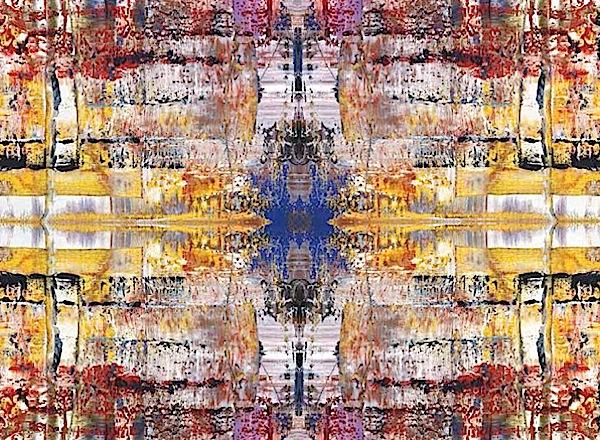A group of four tapestries by Gerhard Richter entitled Abdu, Iblan, Musa, and Yusuf (all 2009) is the subject of a new exhibition at the Gagosian Gallery in London. These works are based on Abstract Painting (724-4) (1990), a key example of Richter’s distinctive approach to non-representational painting. The visual effect of the tapestries is a Rorschach-like multiplying of the forms and colors of the original canvas. Since the mid 20th century contemporary artists such as Pablo Picasso, Joan Miro and Henry Moore have experimented with the medium.
Woven on a mechanical jacquard loom, each tapestry repeats four times the image of one quadrant of the painting. Somewhat surprisingly, the painterly, stochastic qualities of the original translate onto the loom’s digital iterations. Though derived from the same painting, each of the four tapestries surprises and dazzles with its own complex symmetries. In Abdu, a cobalt blue supernova erupts into a sea of overlapping reds, mixed whites, and yellows; while Iblan is a layered vision of lilacs and midnight blues that emanates from a bright white center. Within a delicate red top-layer, some marks appear to have been finger-painted; given such refined illusions of gesture it is easy to forget that the works do not employ paint at all.
In recent years, Richter’s interests in media-merging and appropriation have resulted in works that multiply and transform his abstract paintings into prints, books, and other paintings. The digitally generated Strip paintings of 2012 are complex manipulations of the same painting from which the four tapestries were produced. But in the tapestries, the continuous probing of the space between painting and photographic reproduction finds resonance in the textures of the artisanal medium, rather than in the smooth depiction of color and speed. Translated from paint to wool, Richter’s distinctive abstraction imbues a traditional medium with new dynamism, while the act of painting itself passes into a parallel tactile realm.
Gerhard Richter was born in Dresden, Germany in 1932. His work has been shown and collected by museums throughout the world. Major exhibitions include “Gerhard Richter: Paintings,” Art Gallery of Ontario, Toronto (1988, traveled to Museum of Contemporary Art, Chicago; Hirshhorn Museum and Sculpture Garden, Washington, D.C.; and San Francisco Museum of Modern Art); Tate Gallery, London (1991); Museo Nacional Centro de Arte Reina Sofía, Madrid (1994); “Gerhard Richter: Eight Grey,” Deutsche Guggenheim, Berlin (2002); “Gerhard Richter: 40 Years of Painting,” Museum of Modern Art, New York (2002, traveled to Art Institute of Chicago; San Francisco Museum of Modern Art; and Hirshhorn Museum and Sculpture Garden, Washington, D.C.); “Gerhard Richter: Printed!,” Kunst Museum Bonn (2004); “Gerhard Richter: Paintings 1963–2007,” National Museum of China, Beijing (2008); “Gerhard Richter: Portraits,” National Portrait Gallery, London (2009); “Gerhard Richter: Abstract Paintings,” Museum Ludwig, Cologne (2008–09, traveled to Haus der Kunst, Munich); and “Gerhard Richter: Panorama,” Tate Modern, London (2011–12, traveled to Neue Nationalgalerie, Berlin; and Centre Pompidou, Paris).

